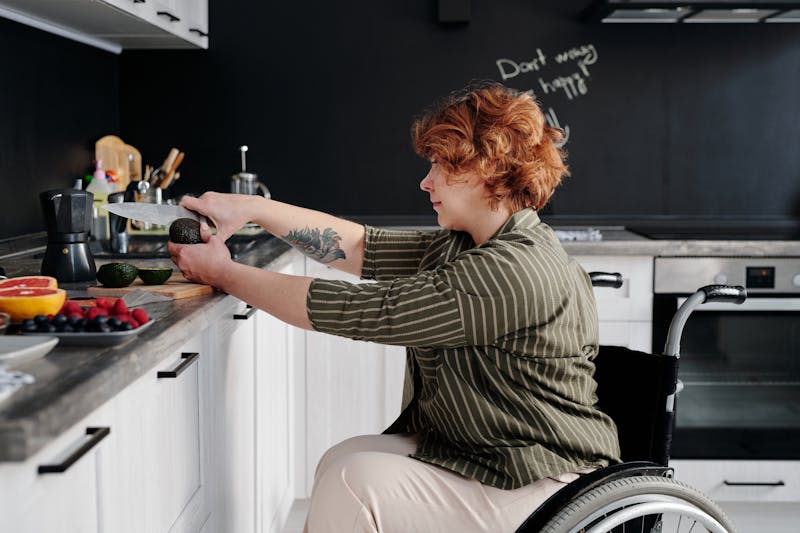
Does your kitchen inspire you to create delicious, comforting meals, or is navigating around it more akin to an obstacle course? If it’s the latter, have you ever paused to reconsider your kitchen design? Could it be more accessible, more user-friendly, and importantly, could it cater to the wide range of differing needs in every Australian household? Can we make kitchens more disability friendly for all? Notably, these questions bring us to the concept of the National Disability Insurance Scheme (NDIS) Kitchens in Australia. In this blog, we will delve into the essentials of NDIS kitchens, their importance, and how to create the perfect one for your home.
Typically, kitchens are vibrant spaces where delectable food is cooked and shared, but they can also host a variety of hazards if not well designed, especially for those living with disabilities. That’s where NDIS kitchens make their grand entry. Carefully planned and meticulously executed, these kitchens redefine the entire cooking and dining experience.
This exploration won’t stop with the mere detailing of what NDIS kitchens are. Instead, we’re about to embark on a comprehensive journey – one that uncovers why such kitchens are essential, who benefits from them, how to design them, and which unique challenges they solve.
Why NDIS Kitchens?
Understanding why NDIS approved kitchens matter is a good starting point for making our homes inclusive. First, these specially designed kitchens enhance safety and practical accessibility, directly improving the quality of life for people with disabilities. Every element, from counter heights to cabinet configuration, is thoughtfully customized to suit individual needs.
Second, these kitchens foster a greater sense of independence. By accommodating the unique needs of every individual living in the house, NDIS kitchens empower residents to comfortably navigate the kitchen space, cook their own meals, and engage in chores or activities of their choice.
Finally, aside from their functional advantages, these kitchens present a beautiful balance between style and purpose. Balancing aesthetic considerations with the practical needs of those with different abilities leads to a harmonious and welcoming home space.
What Constitutes an NDIS Kitchen?
Crucial to the creation of an NDIS kitchen is the use of adaptive features that enhance accessibility and ease of use. These could range from adjustable countertops and cabinets to easy-to-use appliances and slip-resistant flooring.
Similarly, the design should leave ample space for movement, particularly considering the extra space needed when a wheelchair is used. Lighting is another key element. A well-lit kitchen minimizes accidents and ensures the area is usable during all times of the day.
Lastly, smart technology now plays a monumental role in modern kitchens. From voice-controlled devices to automated elements, these wouldn’t be out of place in an NDIS kitchen, acting as additional assets for ensuring easy navigation.
When and Who Should Opt for NDIS Kitchens?
Anyone living with a disability that affects their mobility should consider an NDIS kitchen. Even those anticipating a future need due to aging or progressive illness could benefit significantly from an early conversion. There’s never a wrong time to make your home more accessible – the sooner, the better.
For families living with members who have varying levels of mobility, an NDIS kitchen could be a boon. It fosters a sense of inclusivity and facilitates independence for those members, supporting their desire to partake in various kitchen activities without feeling restricted.

NDIS Kitchens
The Benefits and Challenges of NDIS Kitchens
NDIS kitchens certainly bring a plethora of benefits – heightened safety, improved independent mobility, and social inclusivity. However, they’re not without their challenges. One of the significant obstacles is the cost and potential disruption associated with remodeling a kitchen into an NDIS-approved one.
Choosing the Right Materials and Appliances
When planning your NDIS kitchen, choosing the right materials and appliances matters extensively. You’ll want to find options that are durable, non-slip, heat-resistant, and accessible. The appliances must be easy to use and adaptable to individual needs. High-quality material selection and smart appliance choices ultimately underpin an efficient NDIS kitchen.
Engaging a Professional Design Team
Finding designers experienced with NDIS regulations is essential. They would be able to guide the design process, ensuring the end result meets legal requirements, increases functionality, and enhances aesthetics. Their familiarity with available products, structural needs, and spatial designs could bring your vision to life in a practical, visually appealing manner.
Conclusion
NDIS kitchens aren’t just about accessibility and safety; they’re about empowering people with different abilities to live their lives without restrictions or compromise. They exemplify how thoughtful, intelligent design can transform daily life in meaningful ways.
While embarking on the NDIS kitchen journey can indeed be challenging, remember that the multilayered benefits of such an upgrade far outweigh the initial expenses and hassles. You’ll not only create an accessible and welcoming environment for all, but you will also enhance the overall aesthetic appeal of your kitchen. So why wait? Get started on embracing inclusivity and style today with the amazing world of NDIS kitchens.





